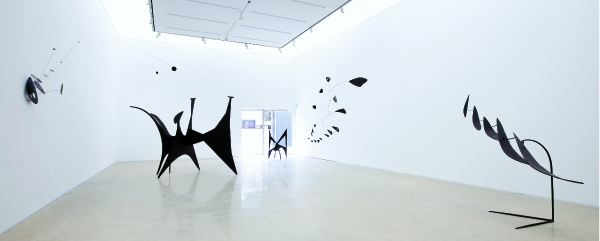Exhibit shows the ‘stabile’ side of Calder

The Alexander Calder solo show “Noir” is at Kukje Gallery through Aug. 17. 2012 Calder Foundation, New York / Artists Rights Society (ARS), New York. Provided by the gallery
American artist Alexander Calder (1898-1976) is usually remembered as the creator of the mobile. His name conjures up images of suspended abstract forms of vivid primary colors moving with the air.
However, Alexander S.C. Rower, president of the Calder Foundation and grandson of the sculptor, has a different perspective. “Colors, forms and movements are not the most important in Calder’s works,” he said.
Rower was in Seoul for Calder’s solo show titled “Noir” at Kukje Galley in the art zone east of Gyeongbok Palace in central Seoul.
“His works are made not only of wire, steel and paint, but also of space and time,” he said. “Unlike paintings, which are finished before viewers look at them and have no significant interactions with surroundings, Calder’s sculptures are completed when viewers look at their relations with the space around them at a certain time.”
The exhibition contains only black sculptures to emphasize the qualities of the works that are just like “drawing three-dimensional figures in space,” according to the gallery.
The exhibit includes not only mobiles, but also immobile sculptures known as “stabiles.”
The common characteristic of Calder’s mobiles and stabiles is “their solidity without mass,” Rower said.
“When staying quiet you will see something occurring between Calder’s sculptures, if you have more than five senses,” he said. “Calder was interested in energy flows between objects and in the universe. He thought the works he made became charged with energy and would exude energy.
“He was understanding energy flows, which can be the chi of East Asian philosophy, not in spiritual or religious ways, but he had intuitional understanding of it.”
* The show runs through Aug. 17. Admission is free. Hours are Monday to Saturday 10 a.m. to 6 p.m. and until 5 p.m. Sunday. Go to Anguk Station, line No. 3, exit 1, and walk 10 minutes. For more information, visit www.kukje.org or call (02) 735-8449.
By Moon So-young [symoon@joongang.co.kr]










with the Korea JoongAng Daily
To write comments, please log in to one of the accounts.
Standards Board Policy (0/250자)